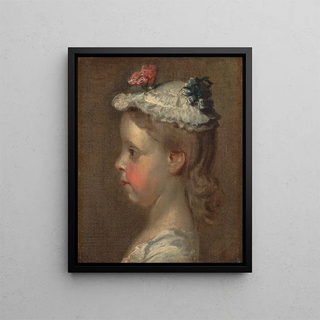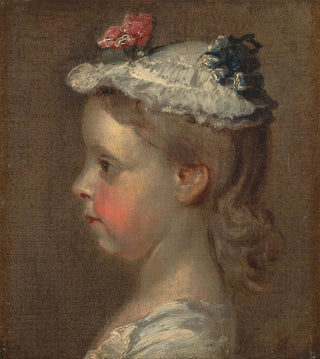Art print | Study of a Girl's Head - William Hogarth


View from behind

Frame (optional)
William Hogarth's "Study of a Girl's Head" is a captivating piece that invites deep contemplation. This study, often perceived as a simple sketch, actually reveals the complexity and richness of human emotions. Hogarth, master of portraiture and visual storytelling, manages to capture the soul of a young girl through delicate features and striking expressiveness. This artwork is much more than a mere academic exercise; it bears witness to the artist's obsession with faithfully representing human nature. Through this art print, the viewer is transported to the 18th century, where art and daily life intertwine with rare elegance.
Style and uniqueness of the work
The originality of "Study of a Girl's Head" lies in Hogarth's distinctive style, which combines realism and stylization. The artist uses flowing lines and subtle shadows to bring his subject to life. Every brushstroke seems charged with intention, and every detail is carefully thought out to evoke an emotion or thought. The posture of the young girl, slightly tilted, and the expression on her face, both gentle and pensive, create a silent dialogue between the artwork and the viewer. This introspective approach is characteristic of Hogarth, who does not merely depict figures but seeks to explore the psychology of his subjects. The color palette, although limited, is chosen with care, highlighting the brightness of the girl's complexion while emphasizing shadows that deepen her emotional depth.
The artist and his influence
William Hogarth, born in 1697, is often regarded as one of the pioneers of narrative painting in England. His work is marked by a desire to tell stories through images, a process that has profoundly influenced the development of modern art. By incorporating elements of social satire and moral critique, Hogarth was able to capture the tensions of his time, while highlighting emblematic characters of British society. "Study of a Girl's Head" fits into this tradition, demonstrating his ability to transcend simple portraiture to address universal themes

Matte finish

View from behind

Frame (optional)
William Hogarth's "Study of a Girl's Head" is a captivating piece that invites deep contemplation. This study, often perceived as a simple sketch, actually reveals the complexity and richness of human emotions. Hogarth, master of portraiture and visual storytelling, manages to capture the soul of a young girl through delicate features and striking expressiveness. This artwork is much more than a mere academic exercise; it bears witness to the artist's obsession with faithfully representing human nature. Through this art print, the viewer is transported to the 18th century, where art and daily life intertwine with rare elegance.
Style and uniqueness of the work
The originality of "Study of a Girl's Head" lies in Hogarth's distinctive style, which combines realism and stylization. The artist uses flowing lines and subtle shadows to bring his subject to life. Every brushstroke seems charged with intention, and every detail is carefully thought out to evoke an emotion or thought. The posture of the young girl, slightly tilted, and the expression on her face, both gentle and pensive, create a silent dialogue between the artwork and the viewer. This introspective approach is characteristic of Hogarth, who does not merely depict figures but seeks to explore the psychology of his subjects. The color palette, although limited, is chosen with care, highlighting the brightness of the girl's complexion while emphasizing shadows that deepen her emotional depth.
The artist and his influence
William Hogarth, born in 1697, is often regarded as one of the pioneers of narrative painting in England. His work is marked by a desire to tell stories through images, a process that has profoundly influenced the development of modern art. By incorporating elements of social satire and moral critique, Hogarth was able to capture the tensions of his time, while highlighting emblematic characters of British society. "Study of a Girl's Head" fits into this tradition, demonstrating his ability to transcend simple portraiture to address universal themes






